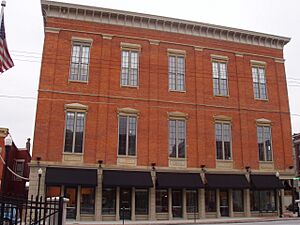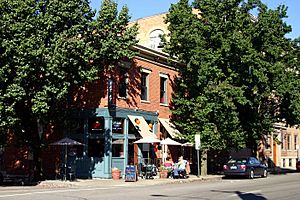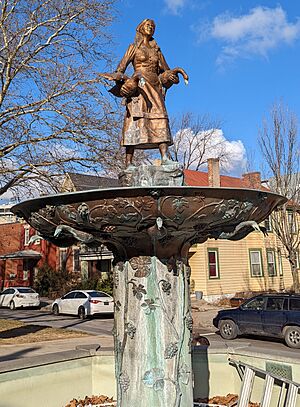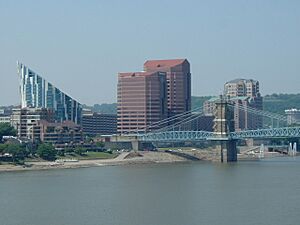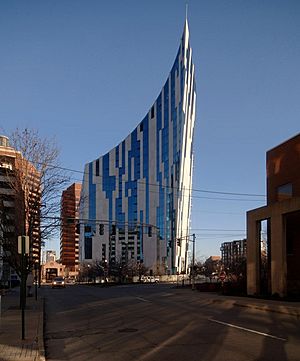History of Covington, Kentucky facts for kids
The history of Covington, Kentucky started in 1815 when the city was first created.
Contents
How Covington Began
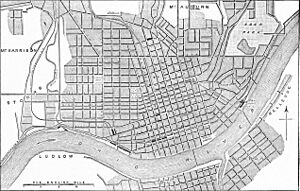
In 1814, three men – John Gano, Richard Gano, and Thomas Carneal – bought about 150 acres of land. This land was located where the Licking River meets the Ohio River. They paid Thomas Kennedy $50,000 for it.
The men named their new company the "Covington Company." They chose this name to honor their friend, Gen. Leonard Covington. He was an American officer who had trained soldiers in the area. He died in the War of 1812.
The investors drew up a plan for the new city. It was designed to be about five blocks wide and five blocks deep. The streets in Covington were lined up with the streets of Cincinnati across the Ohio River. This showed how connected the new city would be to its larger neighbor. The first five streets, running north to south, were named after Kentucky's first five governors.
In February 1815, the Kentucky General Assembly officially made the land into the town of Covington. At that time, Covington was part of Campbell County. Soon after, the investors started selling land lots in the new city for $385 each. However, sales were slow for the next 15 years. By 1830, the city only had 715 people. Land prices had dropped to half their original value.
City Growth and New Neighborhoods
After 1830, Covington's population began to grow a lot. This was mainly because many German immigrants moved there. This growth led to the creation of many different neighborhoods within the city. The Kentucky legislature recognized this growth. In February 1834, they officially made Covington a city. By 1840, the city's population had grown to 2,026 people.
Mutter Gottes/Old Town and Mainstrasse
People were not only living within the city's original borders but also outside them. This led the city to expand for the first time. The city grew to Main Street in the west and 12th Street in the south. This expansion brought in the neighborhoods now known as Mutter Gottes/Old Town and Mainstrasse.
Many Europeans, especially Germans, moved to Covington in the mid-1800s. The main shopping area and gathering place was on Main Street near Sixth Street, now called "Mainstrasse." Sixth Street was made very wide. This allowed the city to set up a public market in the middle of the street in 1861. The nearby Mutter Gottes Kirche (Mother of God Church), built in 1871, was the center of another German-speaking neighborhood.
Old Seminary Square and Westside
As the western part of the city grew, development also moved south. In the late 1830s, the Western Baptist Education Society bought about 370 acres. This land would become the city's southern border in 1841. On this land, the group started a seminary (a school for religious studies). They also set aside 22 acres for a cemetery. This cemetery became known as Linden Grove Cemetery in 1843. Several Civil War soldiers are buried there.
To get money for their campus, the Baptists sold parts of their land. They divided the land into lots around their campus and cemetery. Many graves were left untouched as buildings were constructed in the area. This area is now known as Old Seminary Square, Mainstrasse Village, and the Westside. In 1843, the city added most of the Society's land. This expanded the city's boundaries to 15th Street.
By 1845, the Western Baptist Theological Institute opened on Russell Street. However, within two years, the leaders of the organization argued about slavery. This led to the school closing in 1853. The land was then divided between the two opposing groups. At the same time, tracks for the Covington and Lexington Railroad were laid in the area, cutting through the college campus. Fifteen years later, the original St. Elizabeth Hospital moved into one of the old college buildings. It operated there from 1868 to 1911.
Austinburg and Lewisburg
While the Society was developing its land, Seneca Austin and his wife bought and started developing about 80 acres. This land was along the Licking River, from about 16th Street to 20th Street. This created the neighborhood we now call Austinburg. In 1851, the city added all of the Austins' land up to Wallace Avenue. They also added the western neighborhood now known as Lewisburg. Both communities were settled mostly by Germans. They built churches and parishes as important centers in their communities. St. Benedict's Catholic Church was in Austinburg, and St. John's the Evangelist Catholic Church was in Lewisburg.
Wallace Woods and Levassor Park
Just south of Austinburg were three large estates. These belonged to Robert Wallace, Daniel Holmes, and Eugene Levassor, who were all successful business owners.
In 1867, Holmes built a large 32-room redbrick "castle" called Holmesdale. It was on 17 acres of land next to the Wallace and Levassor estates. After Holmes died, his family sold the mansion and 13 acres to the Covington Board of Education in 1915. The mansion was used as Covington High School until 1936. Then, the building was torn down, and a new high school was built. This building and five others now stand on the former estate grounds as part of the Holmes High School campus.
In the 1890s, the Wallace and Levassor estates were developed. This created fancy neighborhoods at the end of the streetcar line. Many grand homes were built on large lots in these areas.
Peaselburg
West of Wallace Woods and the railroad tracks, a German working-class neighborhood grew in the late 1800s. This community was known as "Peaselburg." In 1880, the community became its own town and changed its name to Central Covington. In 1894, the owners of Wallace Woods agreed to be added to Central Covington. This was because Central Covington's taxes were much lower than Covington's.
The next year, Covington tried to add Central Covington, but it didn't happen. However, ten years later, many homes and businesses in Central Covington were flooded when a major sewer line broke. Covington offered to help the smaller town, but only if the residents agreed to be added to Covington. This happened in 1907. So, Central Covington (and Wallace Woods) became part of Covington. Six years later, St. Augustine Catholic Church was built on 19th Street. It became an important center for this neighborhood.
Latonia and Rosedale
In 1882, a group of investors created the Latonia Agricultural and Stock Association. Their goal was to build a horseracing track south of Covington. They bought over 100 acres of land in an area then called Milldale. Using the name of the nearby Latonia Springs resort, they renamed this area Latonia. The track opened in June 1883. But it wasn't until 1890 that Kenton County allowed the Covington electric streetcar company to lay tracks to this area.
In 1896, part of this area became the city of Latonia, with about 1,500 people. Next to Latonia to the south was a community called Rosedale, which was actually part of Latonia. In 1909, Covington added Latonia and Rosedale. This was partly to help Latonia with its money problems.
West Covington
The independent city of West Covington, once called Economy and now known as Botany Hills, is located along the Ohio River. This city was planned in 1846. St. Ann's Church was built there in 1862 and served this mostly German-Catholic community. Covington tried to add this city in 1873 but failed. However, Covington finally added it in 1916. This was partly because of water problems in the area and the lack of a high school.
Later City Expansions
After West Covington was added in 1916, Covington's borders stayed the same for 35 years. Other towns like Park Hills and Fort Wright grew up around Covington. In the 1950s and 1960s, the city added small pieces of land. These were much smaller than the large areas added in the first 100 years of the city.
During the 1960s, Covington added a lot of land. This helped set the city's current borders. In 1965, the city added about 212 acres near Kyles Lane. In the same year, it added 72 acres near Devou Park, known as Kenton Hills. Finally, in 1965, the city made its biggest expansion ever. It added about 4,000 acres of land south of Latonia. This created the community now known as South Covington.
Population Changes
Covington's population grew a lot from 1830 to 1930. It went from 743 people in 1830 to 24,505 in 1870. By 1900, it reached 42,938. The highest number of people recorded was 65,252 in 1930.
However, because of problems like the Great Depression in the 1930s, the population dropped for the first time in 1940 to 62,018. For the next 20 years, the population stayed around 60,000. In the 1960s and 1970s, many people moved out of the city. This caused the population to drop to its lowest recent count of 40,640 in 2010. In 2014, the population increased slightly to 40,944.
Economic Growth
Early Businesses and Trade
When Covington was new, most of its businesses were connected to the rivers. The Kentucky side of the Ohio River was not very deep. So, Covington could not develop its riverfront for boats and steamships. Instead, these boats docked on the Cincinnati side of the river.
The city's first factory, a cotton factory, was built near the river in 1828. Three years later, another business, a rolling mill and nail factory, was set up along Scott Street.
First Downtown Area
The first main business area of the city was around the "public square." This was located between Third and Fourth Streets and Scott Boulevard and Greenup Street. A market house was built here in 1831. A public well was also dug nearby. In the 1830s, many shops, offices, and other businesses grew in this area.
In the mid-1800s, two things helped Covington grow. First, in 1840, Kenton County was separated from Campbell County. Even though the county seat was supposed to be in the middle of the county, Covington became the main county seat. This was true until the city of Independence was formed in 1842.
Independence was small and about 12 miles from Covington. So, people and lawyers found it easier to do business and handle legal matters at the Covington courthouse. This courthouse was built near the public square in 1843. The Kentucky legislature saw that Covington was acting as the main county seat. In 1860, they passed a law allowing Covington to record deeds and mortgages. This made Kenton County one of only two counties in Kentucky with two county seats.
Madison and Pike Street Businesses
Another big change during this time was the building of the Covington and Lexington Railroad in 1853. The public square stayed important for legal business. But because of the railroad, the area of Madison Avenue and Pike Street became the city's main business center. This lasted through the rest of the 1800s and into the 1900s.
There was a train stop at Russell and Pike Streets. This area quickly became a busy place for businesses. Many packing houses, grocery stores, dry goods stores, meat markets, printers, jewelers, and more than 20 hotels opened here.
After the Civil War, Covington did well. This was because the city had access to tobacco grown in the Bluegrass region. Many cigar factories were in town. Its iron mills, distilleries, glassworks, and stove makers were also important. A new water supply system was introduced in 1871.
Many immigrants to the area were German and Catholic. A Catholic orphanage was built outside town. St Elizabeth Hospital and the Benedictine priory of St Joseph were among the city's main buildings.
By the time of the First World War, Covington had train service from the Chesapeake & Ohio and Louisville & Nashville railroads. It was Kentucky's second-largest city and had its second-largest economy. It also got a Catholic bishopric and a Gothic cathedral. Its factories at that time made textiles, metal castings, machinery, and ropes.
Covington-Cincinnati Suspension Bridge

The next big project that helped Covington's economy grow was the Covington-Cincinnati Suspension Bridge. This bridge connected Covington and Cincinnati. It was built by John A. Roebling, and construction started in 1856. Work stopped for a few years because of an economic downturn and the Civil War. The bridge officially opened on January 1, 1867. This helped more trade happen between Kentucky and Ohio.
Because of economic problems in 1873 and 1893, not many new commercial buildings were constructed in Covington in the late 1800s. However, this changed a lot in the early 1900s.
One reason for this change was that the Suspension Bridge was rebuilt in the late 1890s. It was first designed for horse-drawn carts and people walking. But it was updated to handle electric streetcars and, later, cars. In the early 1900s, many new business and government buildings were constructed in Covington.
Covington's Best Years
The best time for Covington as the main business center for Northern Kentucky was the first two decades of the 1900s. During these years, especially the 1920s, downtown Covington was very busy. Many restaurants, department stores, shops, banks, theaters, and offices brought lots of people to the downtown area.
Many buildings were constructed during this time of growth. These included the city and county building, finished in 1902. The Cincinnati, Newport, and Covington Railway Company headquarters was completed in 1903. Many other commercial buildings from this time still stand today. These include the Masonic Lodge at Fourth and Scott Boulevard and the Greyhound Bus Station building.
Covington also became the financial center of Northern Kentucky during this period. Many banks were located there, mostly on Madison Avenue.
Manufacturing also grew a lot in Covington at this time. The Stewart Iron Work Company was very important. It employed as many as 600 people in 1915. It was a secret that Stewart Iron Works made special "non-sawable" bars for the cells at Alcatraz Prison. The Bavarian Brewery was a large employer until Prohibition in 1918. Other manufacturing companies included the United States Motor Truck Company and Kelley-Koett Manufacturing Corp., an early maker of x-ray equipment.
Covington is known for its beautiful churches. One of the city's most famous buildings, St. Mary's Basilica Cathedral of the Assumption, was built during this time. It was dedicated in 1910. The city also got two of its most loved parks: Goebel Park in the Mainstrasse neighborhood and Devou Park, a large area of land in the western hills.
A Time of Decline
The Great Depression in the 1930s hurt many businesses and people in Covington. But the city's decline became very clear in the 1960s. As mentioned, the city's population stayed about the same for three decades. But after World War II, many people moved out of the city. Also, there was a big drop in the city's manufacturing jobs. This caused a major decrease in both the number of workers and residents.
If the 1920s were Covington's last great decade, then the 1970s (and early 1980s) were the worst time for the city, especially its downtown. Even though the federal government built an IRS service center in the 1960s, which brought many new jobs, the city started to decline. This continued for several decades. In the late 1970s, the U.S. Department of Housing and Urban Development even called Covington one of the country's "most distressed cities."
During this time, new shopping centers and malls grew in the suburbs. Many long-standing Covington stores either closed or left downtown. Many of these empty storefronts remained empty or were replaced by less appealing businesses.
Covington's Rebirth
Covington began to recover in the mid-to-late 1980s. New buildings were constructed, jobs were created, and the population loss started to slow down.
Covington's return as a business center happened in the same place where it first grew: along the Ohio River and in one of its first business areas, Main Street. The comeback on the river began in 1984. A developer built the Riverside Terrace condominium complex. Two years later, he built Riverside Plaza, another condominium project.
The city and state invested about $7 million in improvements in the late 1970s and early 1980s. This included building the 100-foot Carroll Chimes Bell Tower in Goebel Park. Main Street and Sixth Street were renamed "Mainstrasse." It returned to its roots as a German village with restaurants, taverns, and special shops.
In the mid-to-late 1980s, the city started buying properties along the Ohio River to redevelop them. In 1988, the city and a local developer made a plan to redevelop the riverfront. This really kicked off the city's comeback. The first part of this plan happened in 1990. An 18-story office tower and a hotel were built on top of a large parking garage.
In 1994, Fidelity Investments built a campus in Covington. It had three office buildings and employed 2,000 people. At the same time, the IRS Gateway Center was built on Scott Boulevard. It would employ about 2,000 IRS workers.
In 1997, Rivercenter II was built next to the first downtown office tower. A new parking garage was also built across Madison Avenue. A year later, a hotel was built on top of part of the garage. Two years after that, office space was built on the rest of the parking garage, now called Madison Place. On top of this office space, luxury homes called Domaine de la Rive were built.
In 1998, the state of Kentucky helped build the Northern Kentucky Convention Center. In 2001, an expansion of the Gateway Center was added. Another block away, Roebling Row Apartments were built. These were luxury apartments designed to fit in with the historic neighborhood.
Meanwhile, many new homes were being built in the southern part of the city. New neighborhoods like Ridgeport, Clover Meadow, and Heathermoor were built in South Covington in the 1990s.
Covington in the 21st Century
Covington has continued to work on its comeback into the 21st century. The redevelopment along the riverfront slowly moved south into the downtown area. Some existing buildings were fixed up, and new businesses moved in. But by December 2011, almost one-third of the commercial spaces were still empty.
In 2005, Covington tried to attract "creative" people to its business district. The city created the Covington Arts and Technology Zone ("CATZ"). After six years, city leaders realized it wasn't working. So, in 2011, the City Commission voted to end the "Covington Arts and Technology Zone."
In 2008, Corporex finished building a 22-story luxury apartment building called The Ascent at Roebling's Bridge. It was designed by a famous architect, Daniel Libeskind. This unique building won an award for the best high-rise in the Americas in 2008.
Covington's Neighborhood Movement
Covington's recent successes are thanks to dedicated residents and neighborhood groups. The first wave of this neighborhood movement happened in the mid-to-late 1970s. It was part of a plan to improve the city. Many neighborhood groups were formed, and the Covington Neighborhood Action Coalition (CNAC) was created. CNAC was a main group for many active neighborhood associations. Each group sent representatives to CNAC meetings. CNAC worked on citywide issues and supported neighborhood concerns. For example, they opposed a coal dock in Latonia and pushed for better sewers in Peaselburg.
CNAC also received money to create the city's first block watch, which is like today's Neighborhood Watch. The neighborhood movement was strongest in the early 1980s. By the mid-1980s, CNAC's membership decreased. Many citywide issues had been addressed, and there was no money for staff to help the groups. However, some neighborhood associations, like those in Wallace Woods and Licking Riverside, continued their work.
The Neighborhood Watch Program started in 1985. Residents in Latonia began organizing watches after a murder and several break-ins in their area. Watch members work closely with the Covington Police and Code Enforcement Departments. They play a key role in making the community safer.
In 1996, residents asked for a new group like CNAC. At the same time, the Center for Great Neighborhoods of Covington was reorganizing. At the request of residents, the Center agreed to help organize and staff the new group, the Covington Neighborhood Collaborative (CNC). Today, CNC has 12 member organizations. It works on both citywide and neighborhood issues. Several other neighborhoods, including the Eastside, South Covington, and Mainstrasse, also have active neighborhood associations that are not part of CNC.








